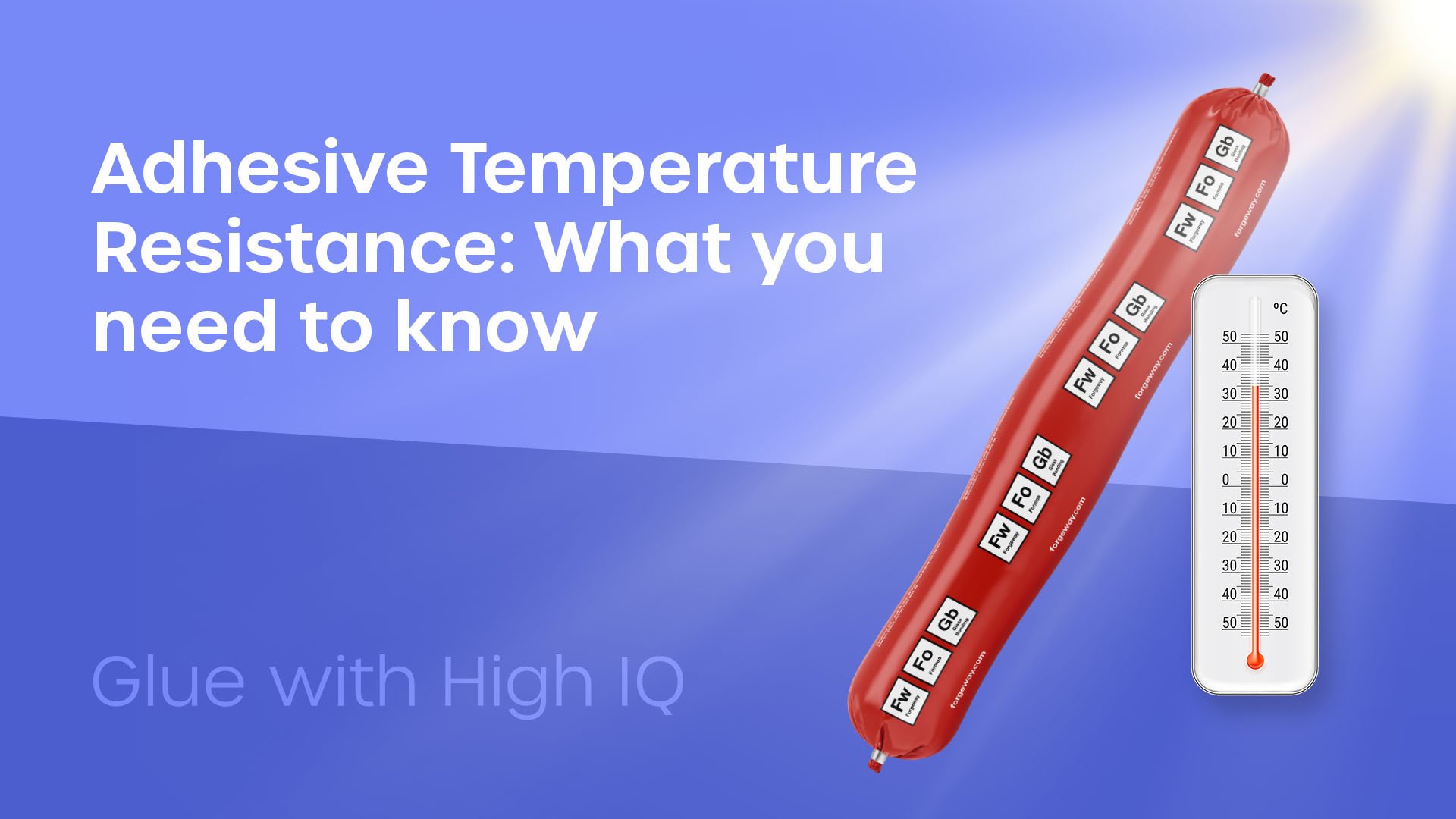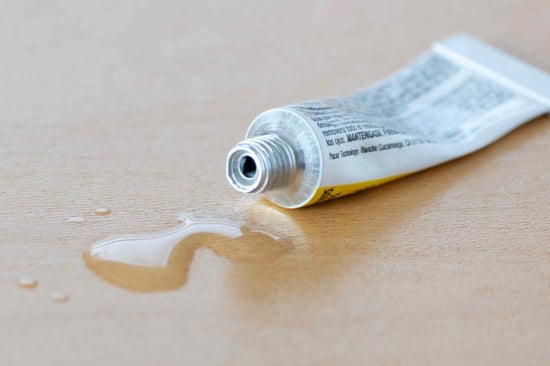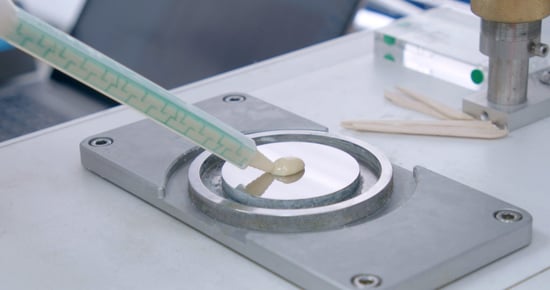Adhesive’s Temperature Resistance: What is it and how can you measure it?

Selecting an adhesive isn’t easy. The right adhesive choice will depend on your application. It will need to have the right characteristics to become the ‘right one’. You likely know that you need to consider the adhesive’s strength, cure speed, and price.
But there are more characteristics that define a ‘good choice’. Much more. And temperature resistance is one of those characteristics.
Here at Forgeway, we manufacture industrial adhesives. We have over 25 years of experience in the adhesive industry. We know that temperature resistance can be an adhesive’s most important characteristic.
So in this article, we will explain the definition of chemical resistance. Then we will describe why adhesive temperature resistance is so important and how you can measure it.
By the end of the article, you’ll have a better understanding of adhesive temperature resistance. You will know what to look out for when selecting an adhesive.
What is adhesive temperature resistance?
Various adhesive experts and manufacturers will give different definitions of adhesive temperature resistance. But having over 25 years of experience in the field, we know that their definitions can be vague.
Defining temperature resistance is very difficult. That’s why we are going to unpack the definition and help you understand what it actually means.
The typical definition is as follows. “Adhesive temperature resistance refers to an adhesive’s ability to withstand exposure to abnormal temperatures.”
Helpful? Do you understand what it means now?
If so, you won’t need to read the rest of this article. But, if you still don’t fully understand adhesive temperature resistance, keep reading.
What qualifies as exposure to abnormal temperatures?
Of course, the answer will depend on so many different factors. You’ll find that ‘normal’ adhesive temperature resistance is typically between 5℃ and 60℃.
We would classify any temperature outside that range as ‘abnormal’. Exposure to these temperatures would require temperature resistance.
Nonetheless, an adhesive could face two types of exposure:
- Sustained exposure. This means exposure to abnormal temperatures for more than 24 hours or more than twice.
- One-off exposure. This means exposure only once or twice and no longer than 24 hours.

What does withstand mean?
Another point people find ambiguous is ‘withstand’. This refers to the adhesive’s ability to remain unaffected. The adhesive must continue to do its job; hold substrates in place.
However, abnormal temperatures can impact an adhesive’s ability to do that. As temperature increases, the adhesive will become softer. This softness will decrease the strength.
The opposite occurs when the temperature decreases. The adhesive will start to become more rigid and brittle. This increases the likelihood of failure when subjected to movement.
The point at which the adhesive transitions to a softer and more rubbery state is the Glass Transition Temperature (Tg). (More on that later).
For example, the adhesive’s Tg (E.g. 120℃) may be at a lower point than the temperatures it will need to withstand (E.g. 200℃). In this case, it will become soft and rubbery. The bond could fail as a result.
The Tg can give an indication of how well an adhesive can withstand high or low temperatures.

Why is temperature resistance important in an adhesive?
An adhesive’s temperature resistance could be its most important characteristic. You may have found the strongest, fastest-curing, and easiest-to-use adhesive.
That is until it faces exposure to abnormal temperatures. Then all of those aspects mean nothing. That’s because exposure to those abnormal temperatures can impact performance. Sometimes to the point of bond failure.
Therefore, you must ensure the adhesive can withstand abnormal temperatures. Boiling hot. Freezing cold. Anything in between. The adhesive must have enough temperature resistance to ensure a strong and durable bond.
Some adhesive applications are critical to life-safety. Not fully considering an adhesive’s temperature requirements could be fatal.

What factors affect an adhesive’s temperature resistance?
Understanding how an adhesive can withstand abnormal temperatures is technical. But there are several different factors which determine an adhesive’s temperature resistance. This section will discuss those factors.
The adhesive’s base chemistry and formulation
An adhesive’s base chemistry can vary massively. The different base chemistries will have different characteristics such as:
- Strength
- Cure time
- Of course, temperature resistance.
Some base chemistries are likely to perform better in abnormal temperatures. Epoxy adhesives are renowned for their heat resistance. Cyanoacrylate adhesives will often maintain performance in low temperatures.
Base chemistry is the biggest factor that will determine an adhesive’s temperature resistance.
It doesn’t stop there. Adhesive manufacturers can take it one step further. They can adjust the formulation to increase resistance to these abnormal temperatures.
Polymers, resins, solvents, and additives are all part of an adhesives formulation. Adjusting these can help manufacturers meet temperature resistance requirements.

The curing process can affect an adhesive’s temperature resistance
Different adhesive types have different curing processes. One-component adhesives will require an external factor (like moisture or heat) to initiate the curing process. Two-component adhesives mix together to trigger the chemical reaction that initiates the curing process.
An inadequate cure will have a large impact on the temperature resistance.
For example, a heat-curing one-component adhesive needs to reach a certain temperature for a set amount of time in order to cure the adhesive fully. Should the adhesive’s requirements not be met, it will result in an incomplete cure.
The same result can occur with two-component adhesives. If the two parts (usually the resin and the hardener) do not mix correctly, the adhesive will not cure fully.
An incomplete cure can have a significant impact on the adhesive’s performance. Its temperature resistance will suffer.
So when applying the adhesive, make sure it has the right conditions to fully cure. This will ensure an incomplete cure will not affect its temperature resistance.

Environmental conditions can degrade an adhesive’s temperature resistance
It’s not just the adhesive’s inherent properties that can degrade performance. External factors can also impact its temperature resistance such as:
- Humidity
- Chemical exposure
- Mechanical stress
These factors can all deteriorate an adhesive’s temperature resistance.
Some adhesives will absorb moisture when facing exposure to high levels of humidity. This absorbed moisture will damage its performance.
The same occurs when an adhesive faces exposure to some chemicals and types of mechanical stress. (Incidentally, chemical and impact resistance are often equally as important as temperature resistance).
This is why it is essential to consider what the adhesive will be exposed to before you choose the right adhesive. The different stresses and factors can damage the performance. Over time, this can deteriorate the adhesive to the point that its temperature resistance will suffer.

How can you be sure the adhesive has enough temperature resistance?
Guaranteeing an adhesive’s performance at abnormal temperatures can be critical to life-safety. Therefore, it’s essential that you can be sure an adhesive has enough temperature resistance.
But how?
The technical number to look out for is the adhesive’s Tg (glass transition temperature).
This number will tell the point at which the adhesive transitions from a rigid, glassy state to a softer, rubbery state. The higher the temperature, the more soft it will become.
Once the adhesive becomes too soft and rubbery, it may not be strong enough to hold the substrates in place.
The opposite is true when facing exposure to low temperatures. As temperatures decrease, adhesives begin to stiffen. The ‘glass transition’ makes the adhesive become more like glass (i.e. stiff and brittle).
You may need the adhesive to have some form of flexibility. In this case, lower temperatures will increase the likelihood of failure.
Analysing the Tg is a good indicator of an adhesive’s temperature resistance. Testing is the best way to ensure your adhesive has enough temperature resistance.

Every application is different. And the unique characteristics of your application may present different results than anticipated.
Testing will recreate your bond in real-life conditions. This will show how much temperature resistance you will actually need.
Testing will show you that you can’t purely focus on an adhesive’s temperature resistance. You need to consider other characteristics too.
We’ll use an example to explain this.
Let’s say you need an adhesive that withstands temperatures above 250℃. You have two adhesives to choose from.
One adhesive will experience a 20% decrease in strength at 250℃. The other adhesive will experience a 50% decrease in strength at 250℃.
It seems obvious which adhesive is the right choice. Yet, you haven’t considered the adhesive’s original strength.
The bond needs an adhesive to have a strength of 10MPa. The first adhesive has a strength of 11MPa which is sufficient. That is until it reaches a temperature of 250℃.
The 20% decrease in strength at this temperature will take it below 10MPa.
The second adhesive has a strength of 27MPa. Even when the adhesive experiences a 50% decrease in strength, it will still be strong enough.
This example shows you why it’s so important to not look at temperature resistance in isolation.
Testing is the best way to ensure your adhesive has sufficient temperature resistance.
What other characteristics are important in an adhesive?
You now have a breakdown of temperature resistance. You understand why it is so important. And you also know how to measure adhesive temperature resistance.
This article should have given you the information you need to choose an adhesive with the right temperature resistance.
However, it’s not always that easy. Here at Forgeway, we have over 25 years of experience. We’ve helped companies choose the perfect adhesive for their application.
We know it’s never easy. There are so many other characteristics that could define a ‘perfect fit’. Temperature resistance is one of many characteristics.
Are you unsure what those other characteristics are? We recommend you read our article on what to consider when choosing an adhesive.
Alternatively, you could reach out to an adhesive expert. A member of the team would be happy to assist you in finding the ‘perfect fit’.
Or if you’d prefer an adhesive recommendation in less than 45 seconds, take the quiz below. It will ask a few questions and provide an adhesive type based on the responses you gave.
Thomas is the Content Manager here at Forgeway. Thomas' job is to translate the technical jargon from the ivory tower of academia into easy-to-read content that everyone can understand. Forgeway's mission is to answer every question our customers and prospective clients ask, or are apprehensive to ask.


